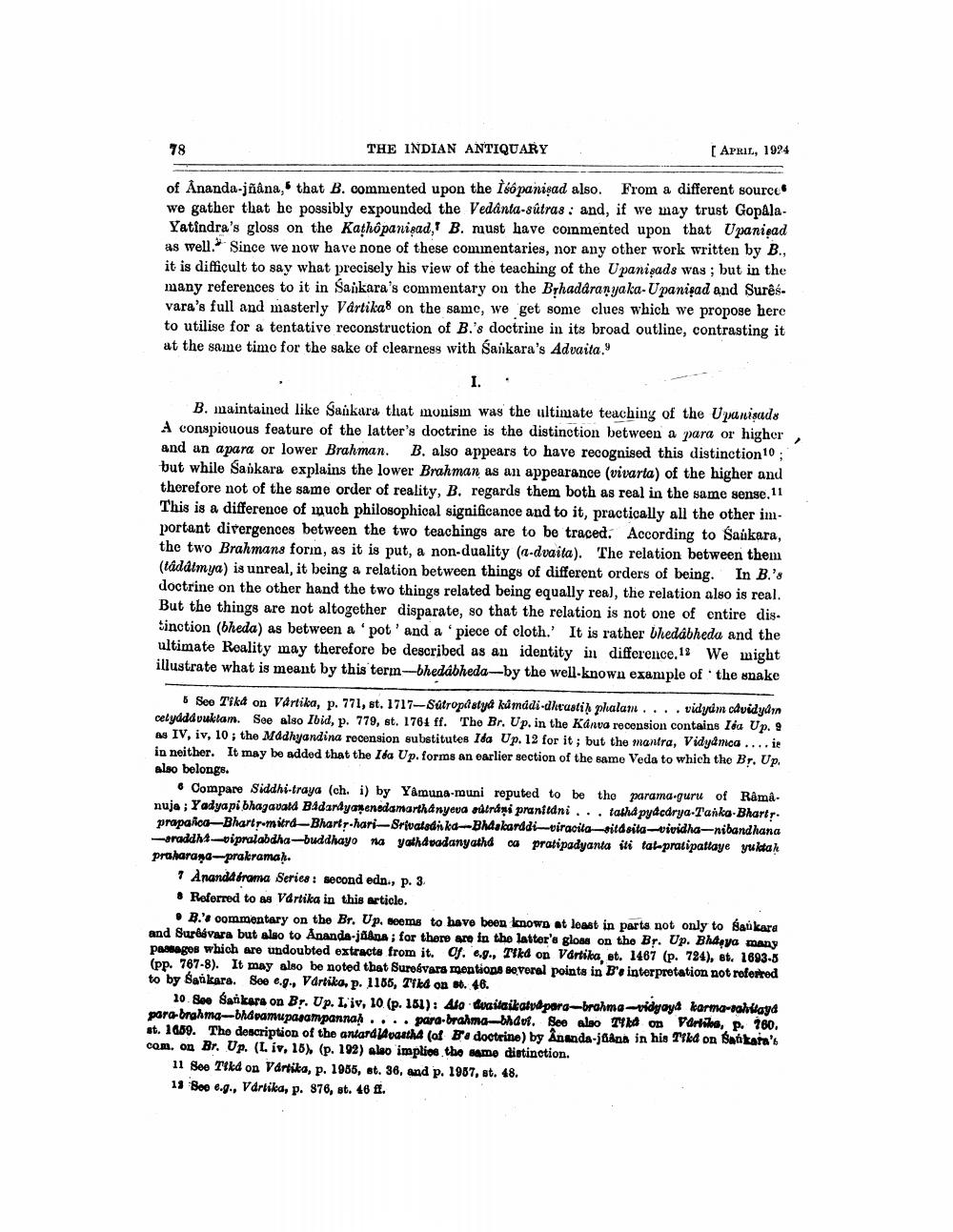________________
78
THE INDIAN ANTIQUARY
of Ananda-jñâna, that B. commented upon the Isopanisad also. From a different source we gather that he possibly expounded the Vedanta-sûtras: and, if we may trust GopalaYatindra's gloss on the Kathopanisad, B. must have commented upon that Upanisad as well. Since we now have none of these commentaries, nor any other work written by B., it is difficult to say what precisely his view of the teaching of the Upanisads was; but in the many references to it in Sankara's commentary on the Bṛhadaranyaka-Upanisad and Surêsvara's full and masterly Vârtikas on the same, we get some clues which we propose here to utilise for a tentative reconstruction of B.'s doctrine in its broad outline, contrasting it at the same time for the sake of clearness with Sankara's Advaita."
[APRIL, 1924
I..
B. maintained like Sankara that monism was the ultimate teaching of the Upanisads A conspicuous feature of the latter's doctrine is the distinction between a para or higher and an apara or lower Brahman. B. also appears to have recognised this distinction10; but while Sankara explains the lower Brahman as an appearance (vivarta) of the higher and therefore not of the same order of reality, B. regards them both as real in the same sense.11 This is a difference of much philosophical significance and to it, practically all the other important divergences between the two teachings are to be traced. According to Saúkara, the two Brahmans form, as it is put, a non-duality (a-dvaita). The relation between them (tâdâtmya) is unreal, it being a relation between things of different orders of being. In B.'s doctrine on the other hand the two things related being equally real, the relation also is real. But the things are not altogether disparate, so that the relation is not one of entire distinction (bheda) as between a 'pot' and a 'piece of cloth.' It is rather bhedabheda and the ultimate Reality may therefore be described as an identity in difference.12 We might illustrate what is meant by this term-bhedabheda-by the well-known example of the snake
5 See Tika on Vartika, p. 771, st. 1717-Sûtropastya kamadi-dhrustiḥ phalam.... vidyam cavidya cetydddvuktam. See also Ibid, p. 779, st. 1761 ff. The Br. Up. in the Kanva recension contains Iéa Up. 9 as IV, iv, 10; the Madhyandina recension substitutes Ida Up. 12 for it; but the mantra, Vidyamca....ie in neither. It may be added that the Iéa Up. forms an earlier section of the same Veda to which the Br. Up. also belongs.
Compare Siddhi-traya (ch. i) by Yamuna-muni reputed to be the parama-guru of Râmânuja; Yadyapi bhagavatd Bidarayanenedamarthanyeva sútráni pranitáni... tatha pyacarya-Tanka-Bhartyprapanca-Bharty-mitra-Bharty-hari-Srivatsdin ka-Bhaskaradi-viracita-sitdeila-vividha-nibandhana -araddha-vipralabdha-buddhayo na yathavadanyathd ca pratipadyanta iti tal-pratipattaye yukaḥ praharana-prakramaḥ.
7 Anandaérama Series: second edn., p. 3.
Referred to as Vartika in this article.
B.'s commentary on the Br. Up. seems to have been known at least in parts not only to Sankara and Suréévara but also to Ananda-jäâna; for there are in the latter's gloss on the Br. Up. Bhasya many passages which are undoubted extracts from it. Of. e.g., Tikd on Vártika, et. 1467 (p. 724), et. 1693-5 (pp. 767-8). It may also be noted that Sureévars mentions several points in B's interpretation not referred to by Sankara. See e.g., Vartika, p. 1155, Tikd on st. 46.
10. See Sankara on Br. Up. Liv, 10 (p. 151): Alo dvaitaikatvapara-brahma-vidyoya karma-tahilayd para-brahma-bhavamupasampannah.... para-brahma-bhdut. See also Tik on Vartika, p. 160. st. 1659. The description of the antardAvastha (of B's doctrine) by Ananda-jaana in his Tika on Sankara's com. on Br. Up. (I. iv, 15), (p. 192) also implies the same distinction.
11 See Ttkd on Vártika, p. 1955, st. 36, and p. 1957, st. 48.
13 Bee e.g., Vartika, p. 876, st. 46 ff.
,




